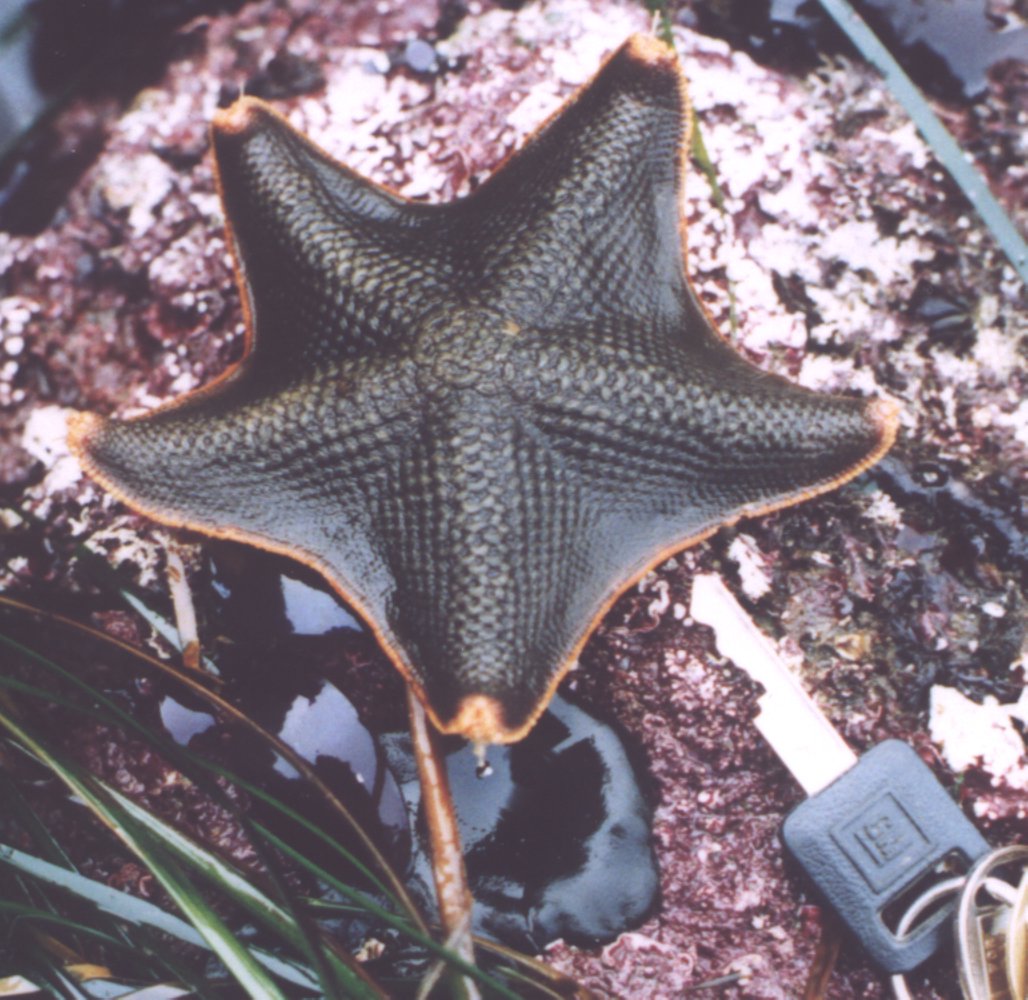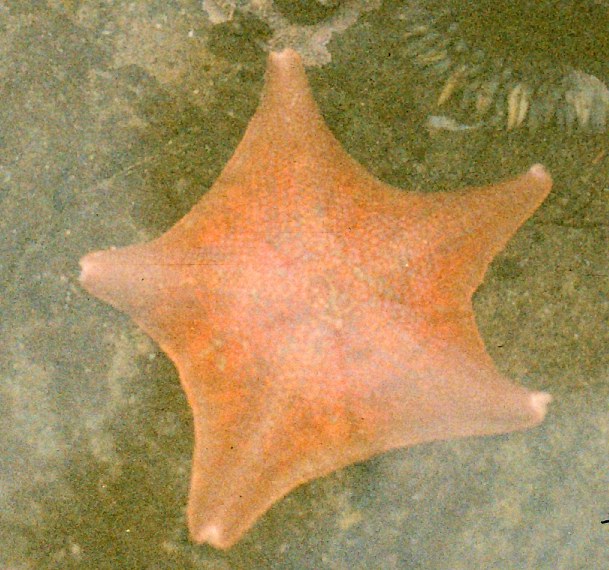Patiria miniata (Brandt, 1835)Common name(s): Bat star, Sea bat, Webbed star, Broad-disk star |
|
| Synonyms:
Asterina miniata |
 |
| Phylum Echinodermata
Class Asteroidea Order Valvatida Suborder Granulosina Family Asterinidae |
|
| A small Patiria miniata at Cape Flattery, WA | |
| (Photo by: Dave Cowles, July 2001) | |
How to Distinguish from Similar Species: Mediaster aequalis has large marginal plates. Pteraster tesselatus has an aboral surface lined with soft tissue and secretes copious slime. Dermasterias imbricata has a smooth aboral surface and is reddish-brown with gray or purple.
Geographical Range: Sitka, Alaska to Baja California and Islas de Revillagigedo, Mexico. Abundant in Central California and Monterey Bay. Uncommon north of California and in Mexico. In our area, only a small population exists at Cape Flattery and another one on the west side of Vancouver Island. In Alaska, only in the extreme low intertidal on the outer coast.
Depth Range: Low intertidal to 290 m.
Habitat: Rocky intertidal, especially near surfgrass, algae, sponges, and bryozoans.
Biology/Natural History: An omnivore and scavenger, feeds mainly on surfgrass. Diet also includes echinoids, algae, sponges, bryozoans, and colonial tunicates, plus organic films on rocks. It cannot open clams. Feeds by everting its stomach, which it may even evert to gather particles from the water. Most animals which avoid other seastars have little response to this species, except for the nudibranch Dendronotus iris, which may swim away. Spawn at least from May to July but ripe individuals can be found throughout the year. Individuals may combat one another if they meet, including pushing, placing a ray over the opponent. May have several individuals of the commensal polychaete worm Ophiodromus pugettensis living on the oral surface or in the ambulacral grooves. This species is often used for developmental studies because ripe individuals can be found throughout the year. Gilpin et al., (2016) found that the bands of cilia on the swimming larvae produce slowly evolving vortices when the larva is swimming. The larvae seem to use different modifications of ciliary beats which serve either to provide efficient propulsion or entrain planktonic algae in the vortices so they can be captured and eaten.
| Return to: | |||
| Main Page | Alphabetic Index | Systematic Index | Glossary |
References:
Dichotomous Keys:Carlton, 2007
Flora and Fairbanks, 1966
Kozloff 1987, 1996
Smith and Carlton, 1975
General References:
Kozloff,
1993
Morris
et al., 1980
Niesen,
1994
Scientific Articles:
Byrne, Maria, 2006. Life history diversity and evolution in the Asterinidae. Integrative and Comparative Biology 46:3 pp 243-254
Gilpin, William, Vivek N. Prakash, and Manu Prakash, 2016. Vortex arrays and ciliary tangles underlie the feeding-swimming trade-off in starfish larvae. Nature Physics doi 10.1038/nphys3981
Hart, Michael W., and Adam Foster, 2013. Highly expressed genes in gonads of the bat star Patiria miniata: gene ontology, expression differences, and gamete recognition loci. Invertebrate Biology 132:3 pp 241-250
Hotchkiss, Frederick C., 2000. On the number of rays in starfish. American Zoologist 40:3 pp. 340-354
Sunday,
Jennifer, Lisa Raeburn, Heather Stewart, and Michael W. Hart, 2009.
Allelic inheritance in naturally occurring parthenogenetic offspring of
the gonochoric sea star Patiria miniata.
Invertebrate Biology
128:3 pp. 276-282
General Notes and Observations: Locations, abundances, unusual behaviors:

An orange individual from a San Simeon, CA tidepool. About 15 cm diameter. Photo by Dave Cowles, May 1995

These individuals were in the bay at Bodega Marine Lab, California. Photograph by Dave Cowles, August 2010
Authors and Editors of Page:
Dave Cowles (2005): Created original page. Edited 2009